
or
A special recognition to Dr. David J. Kersting, D.V.M. for reviewing, commenting, and contributing to the following.
This material was presented at the 2006 Raptors on the Prairie conference
This page is also available in Russian https://www.mybirds.ru/health/rap_health/mutes.php
Although it may not be dinner conversation, much can be learned about your bird by watching what comes out the other end. As yet I have not seen much illustrated on what normal and abnormal raptor mutes look like. There seem to be a few standard statements that all raptor handlers have had to memorize (red flecks in a mute mean coccidia, etc), however actually recognizing normal and abnormal mutes is another matter. Some mutes will immediately look diseased, and there is no question about it. Other mutes can be misread. This is an illustrated guide to raptor mutes.
There are three parts to a mute:
|
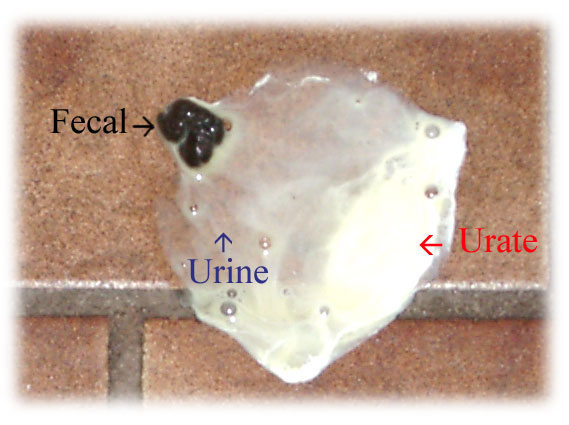
|
Fecals should have a firmness and shape, but not be hard. When fresh and wet, they should have a consistency like toothpaste. Diarrhea is a condition when the fecal doesn't hold any shape.
Urates should be bright white and will be thick when wet. When the urates are any color other than clean white, there may be a problem. The urates do often pick up colors from the fecal, but there is a noticeable difference between this and a colored urate. The lack of urate may indicate kidney malfunctions.
Urine is watery and stringy, like a thin mucous. The urine helps flush the uric acid from the system. Some birds such as the desert birds are highly efficient and need very little urine to flush their waste. Others have far more urine expelled. The lack of urine may indicate dehydration.
The urine and urate may pick up some color from the fecal. This is not abnormal coloration, but just some fecal distributing into the urate and urine.
A good mute to examine is the first mute of the day. This will be particularly large and, in hawks, will be flung with a greater force (called slicing) which will separate the components more. Perch the bird on a low perch in a dimmed room and lay a track of waxed paper or cardboard extending several feet in front of and behind her. Place her on the perch early in the morning, before the sun rises, and wait an hour or so. Some birds will also mute almost immediately after being pulled out of their hawk box if they were left in it overnight. Falcons mute almost straight down and eject with far less force. For their body mass, falcons tend to have smaller mutes, but they tend to mute almost twice as frequently. From experience, falcons have a lot more smell associated with their mutes. A Peregrine can quickly scent an entire room and require it to be aired out, whereas a hawk can go longer before the smell is as noticeable.
Birds have a very fast digestive system and what is fed quickly passes through to the fecal. Because of this, mutes are excellent for diagnosing and indicating disease or illness. In order to casually review mutes on a daily basis, you must have a relatively clean facility for your bird, either hawk box or mews. If the housing is not clean, then this set of information will be lost to you.
When testing a bird for worms, typically the fecal is the only part sampled as this carries the ascarid eggs. However, researchers such as Dr. Mike Hooper have used the urine in their diagnosis. Dr. Hooper's comments about this were that any test using human/mammalian urine could be similarly applied to raptor urine. There could be a wealth of information for diagnosis here.
When examining a mute, consider several factors.
- How large is the fecal? The first mute of the day tends to have a larger fecal than subsequent mutes, so an empty morning mute really does mean that the bird is not processing food. A small mute means that it is emptying, and a large mute means that she is still digesting.
- Does the fecal hold its shape? If the mute is still fresh, fold the waxed paper on itself so the mute is pressed between the two pieces. Press gently. You should feel as though you have some thick toothpaste, not rock hard, and not overly loose and watery. If the fecal is overly hard, again there could be a hydration problem. If the fecal is overly watery, the bird may have diarrhea or may just have a watery mute.
- Is there plenty of urine? If the entire mute is rather dry, your bird may be dehydrated. If she has constant access to fresh, clean water (a freshly scrubbed bathpan and water changed daily), then is she using it? If she eats food that has been stored frozen, are you rehydrating it? To rehydrate the bird, provide her with a fresh, clean bathpan full of water and make "water bombs" to feed her (take strips of rabbit skin and fur, soak thoroughly in water, and feed to the bird to add more water to her system).
- What color is the fecal? Sometimes it's easier to tell when the fecal has been pressed between the waxed paper.
- What color is the urate? Urates may pick up color from the fecal, but they should be a bright white ideally.
- Are there any obvious signs of disease such as worms, foreign bits, or flecks of red coloration? Red coloration will indicate blood coming into the lower GI tract - it is still fresh and red. Black coloration may mean blood is entering the GI tract from higher up - a punctured stomach. Black fecals can also be from the food source. If you are in doubt, change the food source to a food which will not color the mutes and go see your veterinarian.
Variations in fecal color can be completely normal and will vary depending on the food eaten. Some foods are richer in blood, and therefore hemoglobin. Because of this the mute will be black - similar to if the bird herself had bleeding in her upper gastrointestinal tract. If you have mutes that appear abnormal to you, consider the food source, or consult your veterinarian.
All mute photographs were taken after the bird was allowed to eat the same food source for 3 days to ensure that was the only food being digested in her GI tract. Unless otherwise noted, all mutes were generated by the same individual for consistency. Almost all fecals have green in them, and this will color the urine to some degree. Do not be alarmed by this, but make note of what is normal for your bird.
Note: Colors in the following pictures differ depending on light, monitors, and the photo itself. These are not medical diagnosis, but for comparison of the variety.
|
Wet
The mutes will appear dark green. It may be a pale grey-green and be very loose if there has been considerable bone in the meal and a lot of water. |
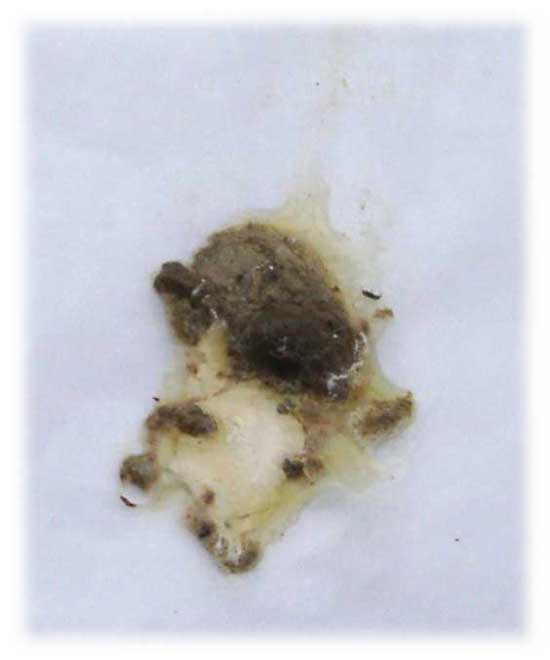
|
|
Dry
The fecal of the mute will retain a dark color that shows the green base to this mute's color. The remainder of the mute will likely reflect a greyish or greyish green. |
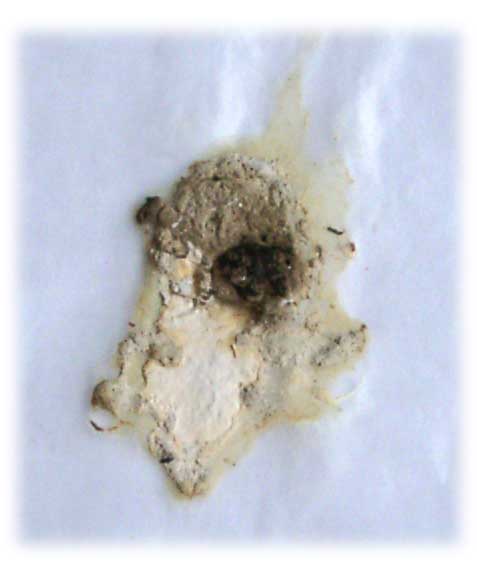
|
|
Wet
The mutes will appear dark brown with a cocoa or green base. |
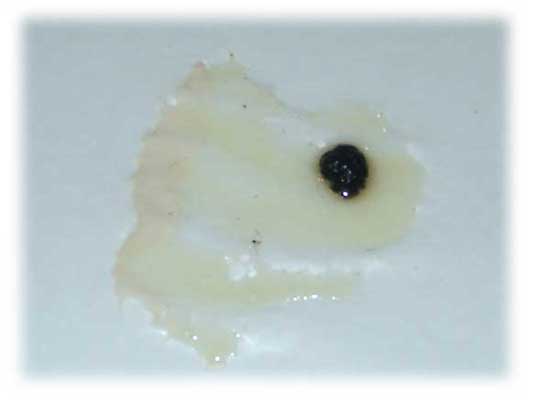
|
|
Wet
Better quality quail leave a darker fecal. Poorer quality quail tend to give a pale or pale green fecal. |
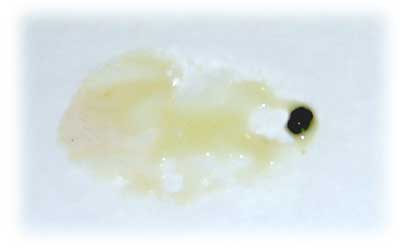
|
|
Dry
|
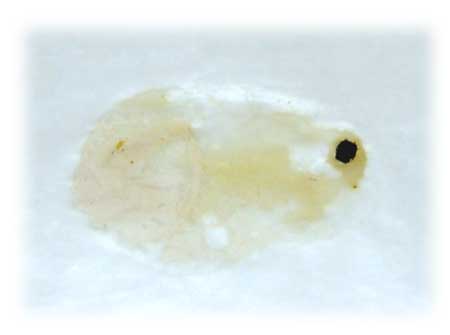
|
|
Wet
Dark green-black, almost tarry fecal due to the amount of hemoglobin in the food. |
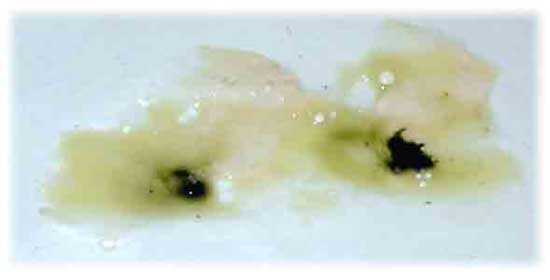
|
|
Dry
Dark black with a green base, almost tarry fecal due to the amount of hemoglobin in the food. |
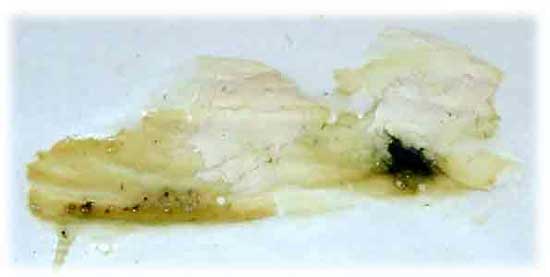
|
|
Wet
Putty colored - brownish grey |
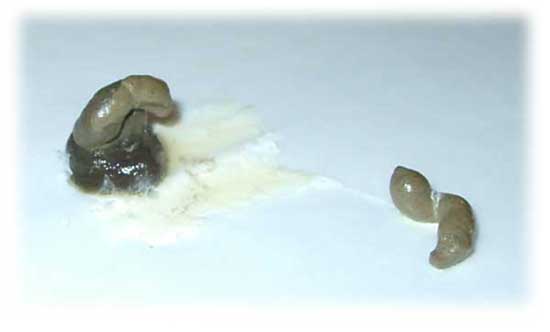
|
|
Wet
Putty colored - light pasty greenish. The more bone consumed and digested, the more pale the mute will be. |
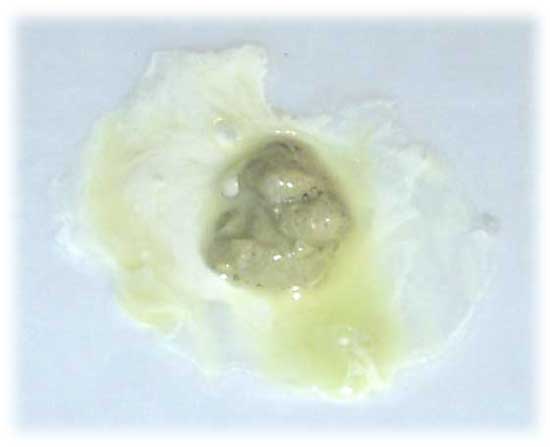
|
|
Dry
Light pale yellow, particularly if there was a considerable amount of bone. The more bone consumed, the lighter the color will be. This may even appear to be slightly crystallized, mostly from the very pale light-lemon color. |
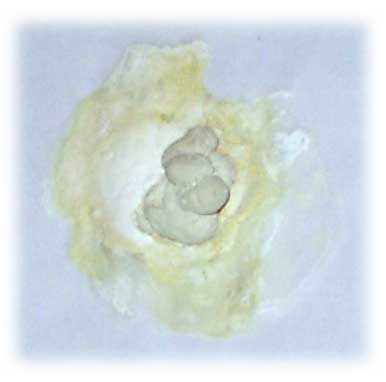
|
|
Wet
Muddy brown tan. Some rehabilitators have noted a pinkish tinge to mutes after feeding rat that I have not been able to explain. I typically notice a distinct odor to both the mutes and castings after eating rat. |
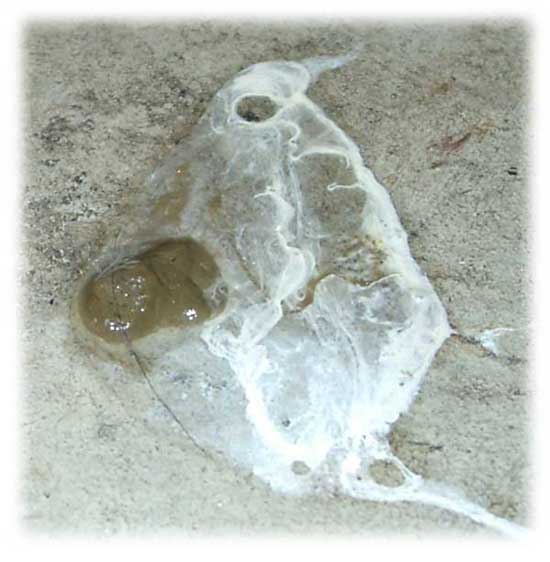
|
|
Dry
Khaki tan |
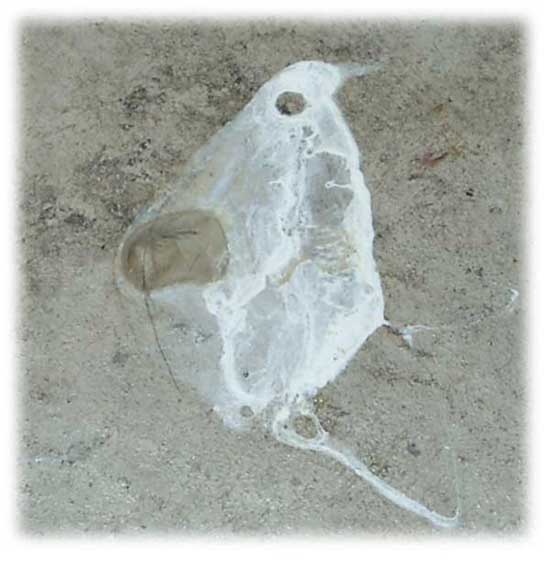
|
|
Wet
Squirrel tends to give a tannish-brown fecal. |
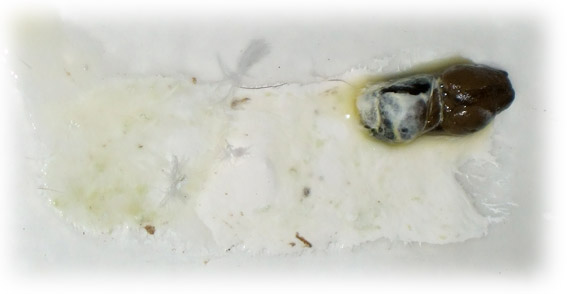
|
|
Dry
Squirrel tends to give a yellowish-tan fecal when dry. |
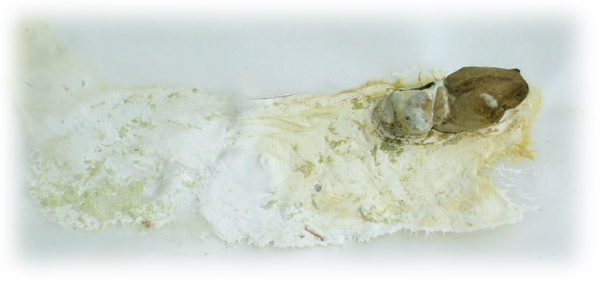
|
|
Dry
Starling tends to give a dark, almost black, look to the mute. |
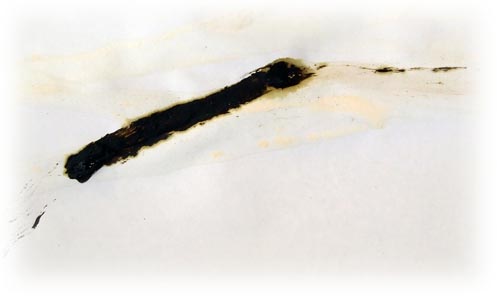
|
|
Wet
Blueish-red - almost looking like blood in areas Photograph courtesy of Shirley Needham. |
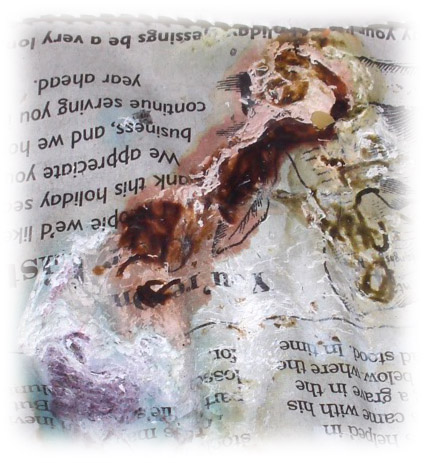
|
|
Empty Mute
An empty mute - no fecal. Her entire GI system may be empty or she may just have an empty cloaca. Likewise this may be normal for the bird or this may be a signal of stress, injury, illness, or hunger. |
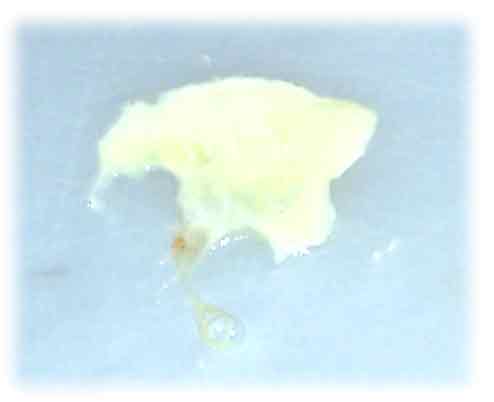
|
|
Wet Rat Mute
Brownish, muddy - note the long mute. This does not hold together as well, but it is not diarrhea. This is a morning mute and as such was ejected with quite a lot of force. What you cannot see is that there is depth; the mute itself stands up off the surface like a long streak of toothpaste. It has body and holds together. The amount of urine is evident at the edges of the fecal trail. |
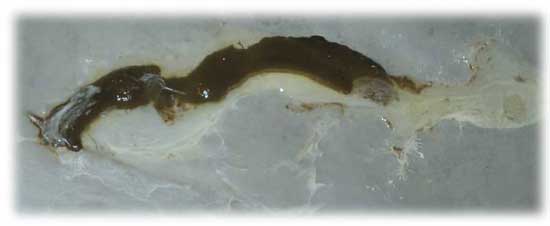
|
|
Wet Mouse Mute
On the far left, the brown fecal from recently eating mice - notice how much fecal there is, but it all holds together. Towards the middle is the crystalline urates - note how very white this is. On the far right is the urine and it has picked up a bit of a greenish tinge, not from disease, but from dissolving some part of the fecal in it. (Quarter shown for relative sizing) |

|
|
Green Mute
This mute is not diseased, but just has a green tinge from the fecal dissolving into the urine. (Example from a different bird eating quail) |
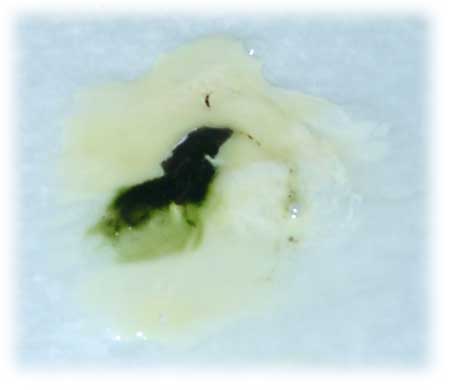
|
|
Well-hydrated
This type of mute might be mistaken for diarrhea as the fecal is broken up. This is not diarrhea, but rather a very well hydrated bird, or possibly an over-hydrated bird. |
||
| Wet | 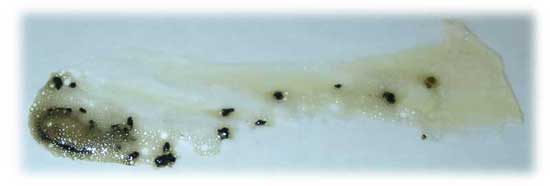
|
|
| Dry | 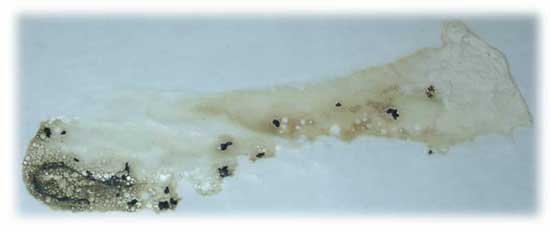
|
|
|
Over Supplemented
This type of mute might be mistaken for diseased of some sort. There is almost a granular texture to the mute and it is yellow or an orangish color. This comes from over supplementing a bird. If you suspect you may be using too much supplement for your bird, feeding a diet of food such as beef heart may mask this type of mute. Change for a few days to a food such as rabbit and see if the mutes come out looking like this. This is from a bird who was slightly over supplemented while eating rabbit. |
||
| Wet | 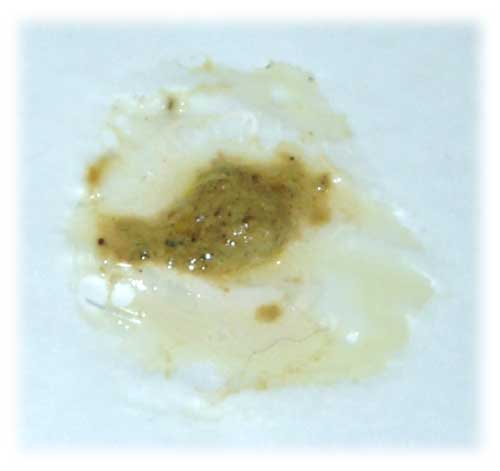
|
|
| Dry | 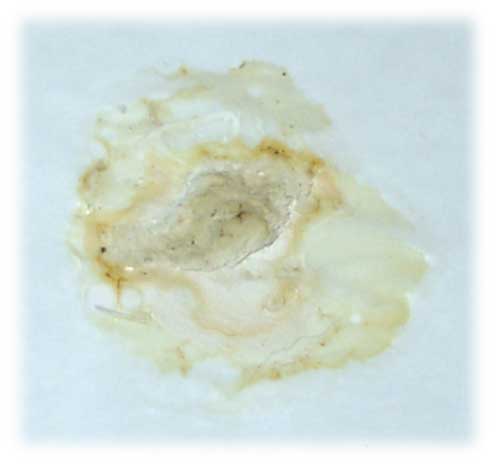
|
|
If you diligently observe the mute, you shall easily prognosticate and foresee her evil, and any such disease as your hawk is infected with. But if her mute be white, intermingled with red, yellow, grey, or such like colour, it is a sign that the hawk is very ill and diseased, and moreover that she stands needful of a scouring, as of mummy purified and beaten to powder, wrapping it in cotton, or some such like matter, to set the gorge and stomach of your hawk in tune again, and other inward parts, as hereafter I shall make further show of in a place meet for that speech and discourse. Assuredly, when you see your hawk's mute so full of diverse colours, it is very necessary for you to respect her cure, and to endeavour yourself to remedy that mischief, or otherwise she must needs perish under your hand, for that those are very deadly signs, and proofs of the ill state of your hawk.
Edmund Bert
The Perfect Booke for Keeping Sparrowhawkes and Goshawkes, 1575
There are several common colors and signs to beware of when observing your raptor. Green may be caused by bile - either from an empty GI tract or from a bird whose system is over-producing bile. Black can be from an upper gastrointestinal bleeding - the hemoglobin giving a tarry black color to the fecal. If the bleeding is in the lower GI tract, the fecal will be more red. You can tell a lot about where the bleeding is originating from by the color of the fecal.
- Increased urates or lack of urine - can signal dehydration
- Red urine - internal bleeding most likely from the vent or from the lower GI tract or from the kidneys
- Pink or red urine/urates - kidney bleeding, lower GI tract damage
- Brown or chocolate urates - can mean lead poisoning, but very strong smelling brown mutes may indicate sour crop
- Green or yellow urates - can mean a liver disease, an empty GI tract, or even starvation
- Black fecal - can indicate internal bleeding in the upper GI
- Neon green mute and frothiness - pancreas is creating too much bile - can also be that something is stuck in the proventriculus causing the bird to create more bile, yet nothing to digest - can be from genetic disease and proper nutrition will balance it
For if the mute be white, and not over thick, nor over clear, and besides not having any black spot in it, or in the least but little, it is an evident proof that the hawk is excellently in tune, and not diseased.
Edmund Bert
The Perfect Booke for Keeping Sparrowhawkes and Goshawkes, 1575
|
Empty Mute
An empty mute - no fecal. Although this may be normal, this can also signal something is wrong. If you know that the bird should be processing food, you must investigate to understand why she is not. It may be that she has vomited the meal she was given. She may have eaten something which has blocked her system. A turkey neck has been known to do this to a large bird like a Gyrfalcon, and chicken necks can certainly do this to a smaller bird. In these cases she would have been able to pass the food out of her crop, but it has lodged lower down in the digestive tract and is blocking any further digestion. It may also be that she is completely impacted from worms and needs to be treated. |

|
But if it be white, and very thick in the middle, well it may import health, but it argues the hawk to be over gross, and too full of grease. And therefore it shall be needful to cure that mischief, by giving her liquid and moist meat, as the heart of a calf, lamb, or such like. And for one or two mornings, to allow her (being empty and having nothing to put over) a quantity of sugar candy by which will scour her, and make her slice, or else a gut of a chicken well ashed, of a convenient length and size, full of good oil olive, well clarified in water, in such sort as hereafter I shall instruct you.
It is easily found, when a hawk is over greasy, and not enseamed, by her mute, when it is white with some black in it, which evil is easily removed by giving her hot sparrows, and young pigeons.
Edmund Bert
The Perfect Booke for Keeping Sparrowhawkes and Goshawkes, 1575
|
Normal White Mute
Although the fecal is difficult to see, this is a perfectly normal mute. This mute is the result of a light, fatty meat and a high calcium intake (turkey meat and bones). The system can only absorb so much of the mineral and the rest is passed through in the mute. |

|
Green mutes typically signal a problem in the liver.
A green mute is also a sign of an infected and corrupt liver, and happily of some apostume, unless she makes that kind of mute upon this occasion, that she has been gorged with some wild and rammage meat, or herself been a rammage hawk: for then this rule does not hold. You must look to this evil as soon and with as great speed as you possibly may, feeding her with meat all powdered with mummy.
It be given her in a casting, or some scouring, continuing it in this manner, sometimes after one fashion, sometimes after another, until you find the mute to be changed from the bad colour to the better. But when this mischief proceeds, and continues a long space, then shall you be fain to bestow on her a scouring of agaric, to rid those evil and noisome humours which do offend your hawk, and after that another scouring of incense beaten into powder, to recomfort her.
Edmund Bert
The Perfect Booke for Keeping Sparrowhawkes and Goshawkes, 1575
Given the symptoms of:
- Difficulty breathing
- Easily exerted
- Extreme thirst
- Weight loss
Given the symptoms of:
- Diarrhea
- Flecks of red
- Foul smelling castings
Given the symptoms of:
- Gasping and coughing
- Neurological dysfunction (shivering, convulsions, seizures, etc)
- Loss of eyesight
- Vomiting
- Lethargy
Given the symptoms of:
- Dull jade green urate
- Listless, even lacking balance
- Puffy, almond eyes or appears blind
Given the symptoms of:
- Food flicking
- White plaques in the mouth
- Difficulty breathing
If you have treated a bird with antibiotics, but the green mutes persist, there may be something else occurring to the liver - green can also come from West Nile Virus and Avian Herpes as well as Avian leucosis, Marek's disease, Salmonellosis, leucocytozoonosis, and infectious coryza. The level of bilirubin may be elevated in the excreted mute due to absorption problems in the GI tract, and so anaerobic GI issues and even lead toxicity are possibilities. There may be a bone shard poking through the proventriculus and irritating the liver. As unlikely as this seems, this has been found on several necropsies and is thought to be not uncommon by some raptor veterinarians.
Try offering materials that will cause castings such as rabbit skin and fur. These may work the shard free and allow it to pass through the system.
Neon green, frothy mutes indicate too much bile. This may be that the liver is creating too much bile. Or it may not be the liver, but rather something stuck in the proventriculus causing excess bile production.
The pigment in avian bile is biliverdin which is green. In the healthy digestive tract ~90% of the bile is absorbed in the jejunum and ileum and recycled.
|
Normal Green Mute
Although green, this is a normal mute. The urates have picked up some color from the fecal mass. The key is the whiteness and evenness of the urate. |

|
|
Green Mute - New Castle's Disease
This green mute came from a bird who died from New Castle's Disease in Pakistan. New Castle's Disease is sometimes described as giving more of a kelly green mute, very bold and bright. Photo courtesy of Salman Ali. |
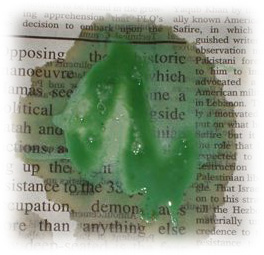
|
|
Green Mute - Unknown
This green mute came from a Saker Falcon that was being treated for hepatitis after the falconer's Barbery Falcon had already developed similar symptoms and died. Photo courtesy of Dr Muhammad Salman Ashraf. |
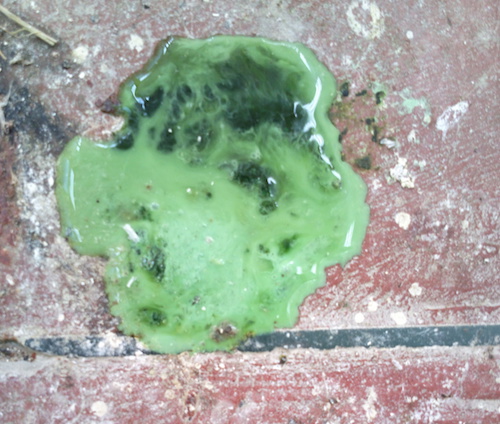
|
Bert's choleric humours points to the yellow bile and the spleen. Yellow can sometimes be a shade of green indicating the liver.
The white mute, having a greater part of yellow in it, that of any other colour, does evidently make show, that the hawk is surcharged with choleric humours, caused and engendered by over great flights, when you fly with your hawk in the heat of the day, as also of over much bating. Which evil you may provide for and eschew, by giving your hawk's meat ashed in cold waters, as buglosse, endive, borrage, and such like wholesome cold waters, very medicinable for that mischief, always remembering to strain the hawk's meat, and wring it in a linen cloth, after you have washed it in the waters aforesaid.
Edmund Bert
The Perfect Booke for Keeping Sparrowhawkes and Goshawkes, 1575
Given the symptoms of:
- Skin has taken on a yellow shade
Given the symptoms of:
- Swollen eyes (conjunctiva and/or cornea)
- Swollen nasal membranes
- Shortness of breath
|
Yellow Mute
This mute came from a very sick Great Horned Owl who gave all symptoms of Chlamydiosis infection. Unfortunately the bird passed before tests could confirm the suspicion. Photograph courtesy of Cindy Alverson. |
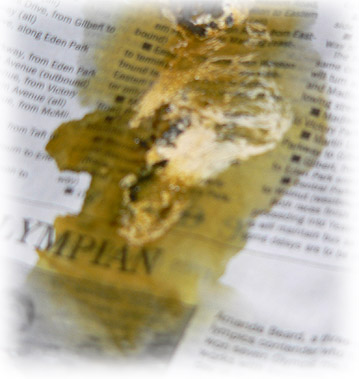
|
|
Yellow Mute
Although not diseased, this mute is from over-supplementing. Lower the supplement dosage and frequency - you are making very expensive mutes and running a risk of overdosing your bird. |

|
|
Yellow/Green Mute - Tuberculosis
This green mute came from a Rough-Legged Hawk who tested positive for Tuberculosis in Russia. The bird exhibited no symptoms other than the green diarrhea. Analysis of the mute discovered the Tuberculosis. Notice the fecal is not holding together - this also illustrates true diarrhea. Photo courtesy of Natalia Grechanaya. |
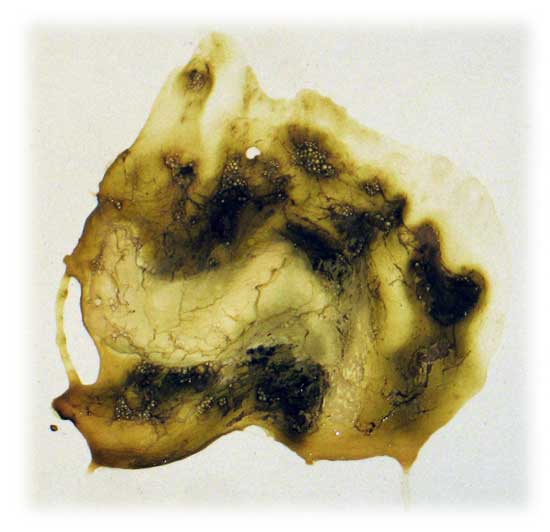
|
Black can indicate bleeding of the upper digestive tract. Bert also noted that black fecals can indicate the bird has taken of the blood of its prey. If you see a black fecal and are concerned, fast the bird or change the food to one guaranteed not to mask any colorations.
The mute of a hawk which is very black, declares her liver to be infected, and is the most deadly sign of all others. For if it continues three or four days, most assuredly the hawk will peck over the perch and die. But if it be so but once, and no more, it greatly kills not. For then may it proceed of one of these two causes: either for that the hawk in pluming and tiring on the fowl, has taken of the blood or guts of the prey, which is a matter of nothing: or else because she has been gorged with filthy meat. In this case it behoves you to respect her, and allow her good warm flesh, and a cotton casting, with mummy or the powder of cloves, to set her stomach in tune again.
Edmund Bert
The Perfect Booke for Keeping Sparrowhawkes and Goshawkes, 1575
Given the symptoms of:
- Diarrhea
- Lethargy
- Food flicking
- Smelly castings
- Lack of appetite
- Brown, slimy castings
|
Normal Black Mute
This is a black fecal from feeding a hawk beef heart. This is normal. |
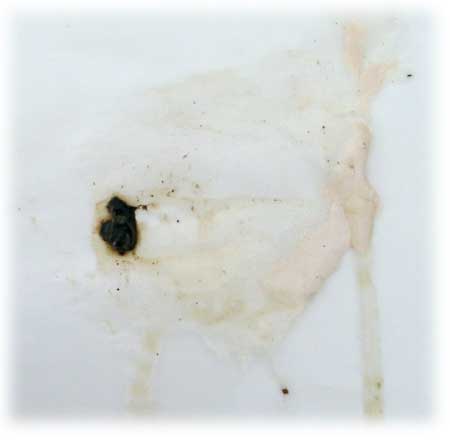
|
|
Normal Black Mute
Although this looks very diseased, this happens to be from a healthy owl. In this case the bird had fasted, then gorged on beef heart producing a mute that was all fecal and no urate. Without understanding the context, this could have been mistaken for a very diseased mute. |
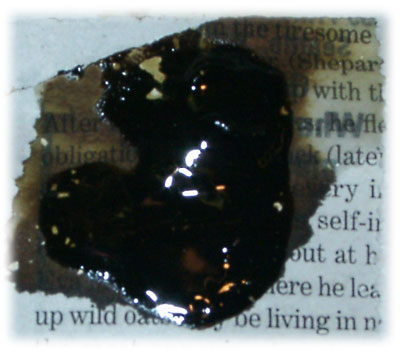
|
Red is never a good sign. Red indicates lower intestinal bleeding or kidney bleeding. Pink in a fresh mute is, essentially, blood and should be treated just as a bright red mute would. A bloody red mute, flecks of blood in the mute, or meat in the mute can also be an indicator of haemorrhagic enteritis or an ulceration of the intestine.
The mute that is tending to red...gives manifest proof, either that the hawk is not well.
Edmund Bert
The Perfect Booke for Keeping Sparrowhawkes and Goshawkes, 1575
Given the symptoms of:
- Preceded by a day or so of larger than normal mutes
Given the symptoms of:
- Flecks of red in the urate
- Diarrhea
- Lethargy
- Food flicking
- Smelly castings
- Lack of appetite
- Brown, slimy castings
|
Pink Mute - Coccidiosis
A fecal test showed this bird had Coccidiosis. From Bill Rhinehart: "Last week she was diagnosed with Isospora. The infestation was severe but there were no blood specks observed in the mutes. The pink mutes were observed a full month before she came down with Coccidiosis. These castings smelled odd but not real bad. They did however have a distinct odor. They also had what appeared to be undigested meat in them. This and the weird weight losses were a real clue. Slimy [castings] Like greasy on the outside. Almost like fatty. Like coated with petroleum jelly. Sugar had diarrhea and wild swings in weight. Her mutes looked exactly like the ones shown on your site of diarrhea." Image courtesy of Bill Rhinehart. |
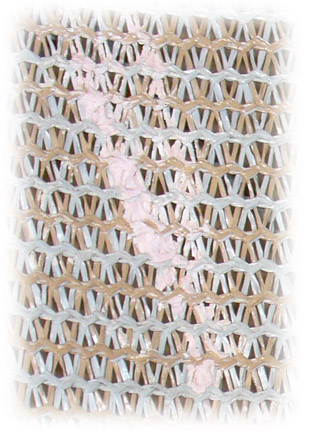
|
|
Red Mute - Streptococcus
A mucus sample taken from the birds throat has Streptococcus growth in it; however that would not be the cause of this. Note the obviously red color of the urates. Similar mutes may be seen when a bird has a vent problem. Image courtesy of Salman Ali. |
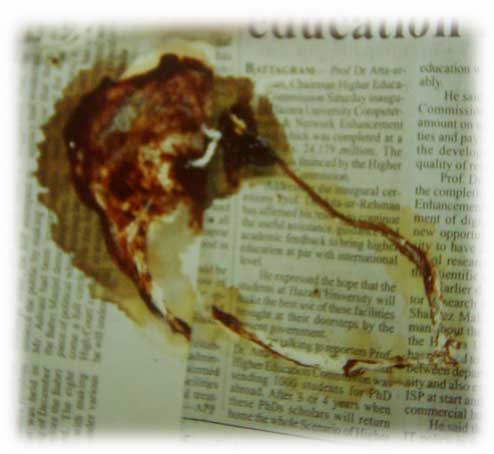
|
|
Red Mute - Bone Shard
This is very similar to a bloody mute from a bound egg. It is believed that this bloody mute was caused by bone shards making a puncture in the lower intestines. Note the obviously red color of the urates. The bird overcame this and is now healthy. Notice how bright and fresh the blood looks - a further indication that the source of the bleeding is very low in the bird and close to the exit. Image courtesy of Salman Ali. |
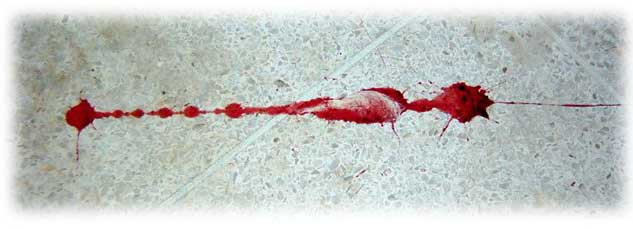
|
Mutes will turn pink over time due to nitrogen eating bacteria flourishing on them. If you suddenly notice your mews is turning pink, it may be a change in the bird or may be that it simply needs to be cleaned. Some rehabilitators notice a pinkish tinge to mutes after feeding rat. I have not observed this, and have no current explanation for it.
|
Pink - normal mute that develops pink over time
This is a perfectly normal mute that developed the pinkish tinge over time. |
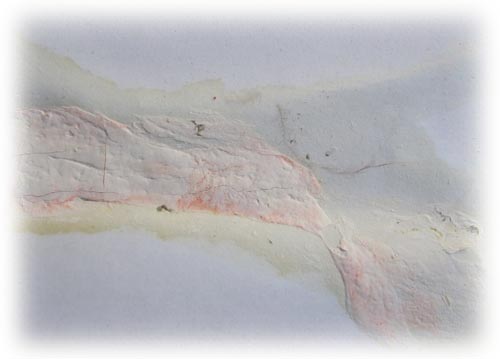
|
|
Pink Mute - Coccidiosis
A fecal test showed this bird had Coccidiosis. From Bill Rhinehart: "Last week she was diagnosed with Isospora. The infestation was severe but there were no blood specks observed in the mutes. The pink mutes were observed a full month before she came down with Coccidiosis. These castings smelled odd but not real bad. They did however have a distinct odor. They also had what appeared to be undigested meat in them. This and the weird weight losses were a real clue. Slimy [castings] Like greasy on the outside. Almost like fatty. Like coated with petroleum jelly. Sugar had diarrhea and wild swings in weight. Her mutes looked exactly like the ones shown on your site of diarrhea." Image courtesy of Bill Rhinehart. |

|
Bert didn't mention brown...
Given the symptoms of:
- Shaking
- Weakness
- Nervous system oddities
Brown mutes that smell very strong indicate sour crop sometimes coupled with a strongyl infection.
|
Brown Mute - Normal
This is a normal brown mute caused by feeding rat. |

|
|
Brown Mute - Bad Meat
This is a brown mute from a Red-Shouldered Hawk resulting from feeding meat that was slightly gone. In this case mice were left out in the sun and not properly defrosted by a volunteer. The mice in the bag were noticed to have a definite stench having decomposed slightly in the sun. The bird did test negative for all worms and has had no more such "muddy" mutes after returning to her regular diet. This really has diarrhea and the fecal is not distinct from the urine or urate. Photo courtesy of rehabilitator Valerie Baldwin. |
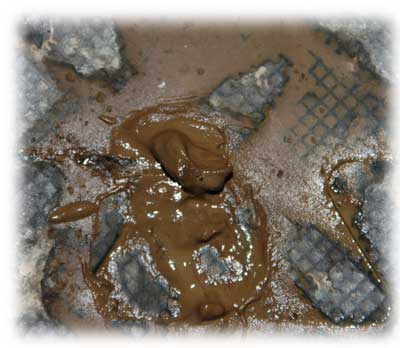
|
|
Brown Mute - Fishy Smelling
This mute is from an adult female Peregrine who has primarily been eating quail. She came in to rehab with a broken wing and after a few months developed a fishy smelling mute. The vet did a fecal float and the bird tested positive for Strongyl. She has been treated with Panacur. The bird has re-tested negative for Strongyl, although the fishy smell sometimes returned. She has been returned to the wild. Photo courtesy of rehabilitator Carla Wakeman. |
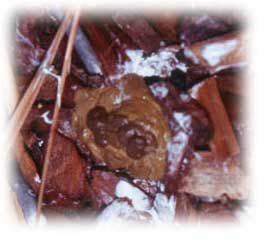
|
The mute that is not perfectly digested... and that is full of small worms, like unto flesh, not perfectly digested and endewed, gives manifest proof, either that the hawk is not well in her gorge, or else that she has been fed with ill or corrupt meats, cold and stinking, and unwholesome for a hawk.
Edmund Bert
The Perfect Booke for Keeping Sparrowhawkes and Goshawkes, 1575
|
Roundworms in the mute
Notice that the fecal is practically liquid and has no shape. The worms make up a great deal of this mute. |
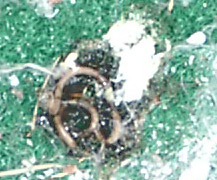
|
|
Worm evidence in the mute
This is from a recently trapped bird who was successfully hunting. The falconer noticed that although she appeared mostly normal, to the trained eye she was slightly sluggish. The bird was successfully manned and had just caught a rabbit when this mute was deposited. At first glance it appeared normal, however when the thick urates settled, these small pink masses were observed. The fecal was saved and tested. This bird tested positive for lungworm and roundworm. After the initial round of treatment with Panacur, the bird perked up and is doing fine. |
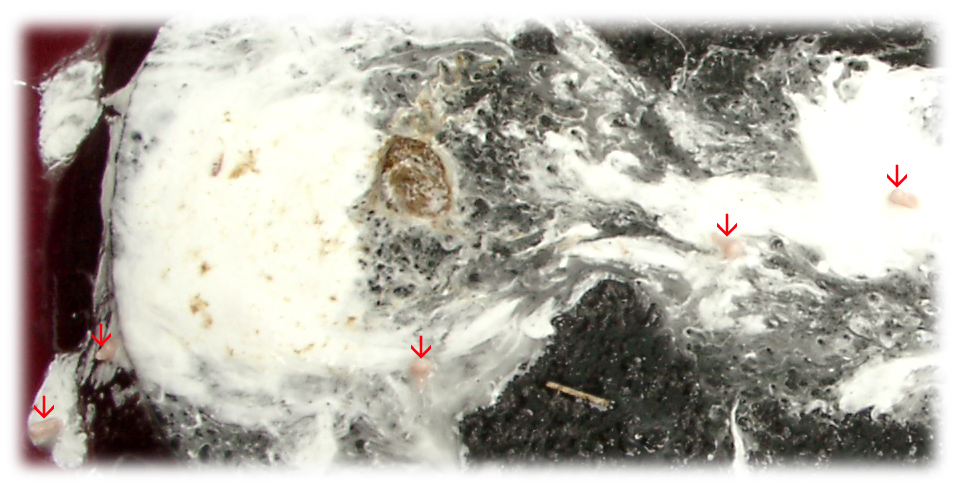
|
|
Worm evidence in the mute
This is from a freshly trapped Peregrine who was trapped in Texas and diagnosed to have tapeworms. The bird was treated with Droncit and this was the result. Photos courtesy of Hubert Quade. |
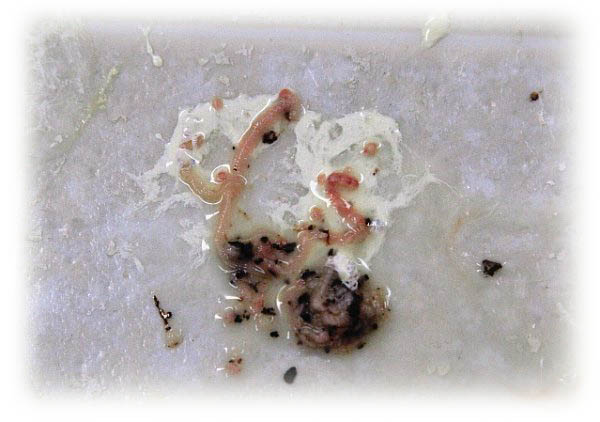
|
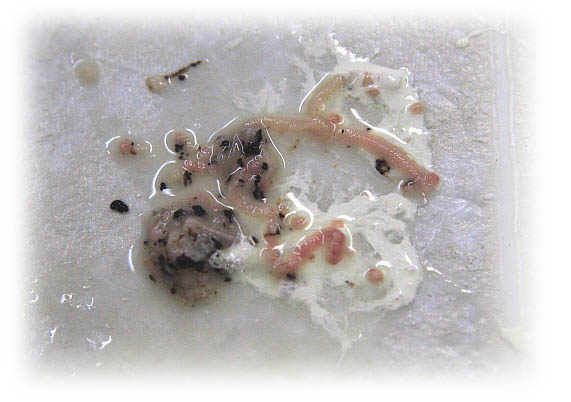
|
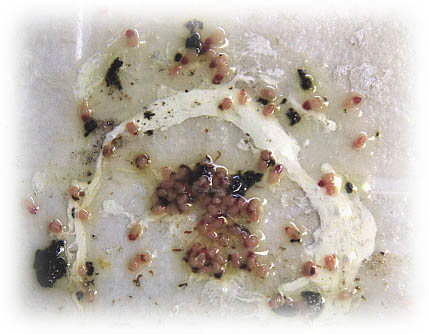
|
Very similar to diarrhea, although the fecals hold their shape better than true diarrhea. True diarrhea or mucal material in the mutes may indicate fowl cholera.
|
Over-Hydrated yet within Normal Range
Nearly identical to diarrhea. |

|
|
Over-Hydrated yet within Normal Range
Nearly identical to diarrhea. Notice the gas bubbles here. When a mute like this is produced, there is a definite sound to it - a frothy sound. When the mute is resting you can actually hear the gas bubbles popping. |
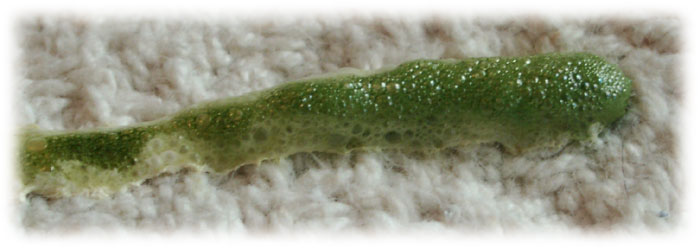
|
By this which I have spoken, as touching the mutes of hawks, it may be gathered how greatly it does import, and how behovefully it is for a falconer, or austringer, for the better cure of his hawks, to peruse every morning with great care the mute of his hawks. For that it does greatly concern the good health and state of them, to find out at the first their indisposition and diseases, before they be too deeply rooted and confirmed in them, when truly it will prove a very hard and difficult matter to remove the evil.
Edmund Bert
The Perfect Booke for Keeping Sparrowhawkes and Goshawkes, 1575
Raptors excrete uric acid which is a concentrated form of nitrogen. Uric acid is a unique excrement in that, unlike urea or ammonia, it can actually be excreted as a solid. Because of this ability, the amount of water needed to flush waste from the system is minimized. If trying to clean wet urates off cement or another smooth surface, the thick chalkiness will easily be detected. When a bird cannot excrete, the buildup of nitrogen in her system becomes toxic. This is why a bird cannot be kept bound or cast for an extended period of time, and why when a cloaca is blocked the result is toxemia.
Since this is an acid, it can eat away a finish slightly and really stick to any surface with the tenacity of concrete. To release the acid, you will have to use a mild base. A baking soda paste scrubbed in well works pretty well at removing mutes from larger surfaces, such as a garage floor or a mews wall. A power sprayer will also physically drive the mutes off the surface. If you have something more expensive that needs to be cleaned, like your couch or your carpet, let the mute dry and then use Poop-Off to clean the area. Oxyclean is also an excellent cleaner removing caked on urate from many materials. In fact, feathers which have gotten mute smeared on them can be dipped in Oxyclean and rinsed to clean them.
Poop Off! For precious items, like your couch or carpet https://www.amazon.com/Poop-Off-Bird-Remover-Sprayer-32-Ounce/dp/B0002G7ZQE